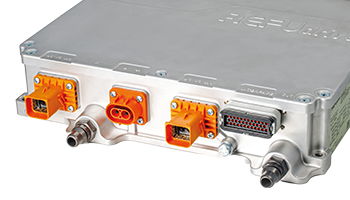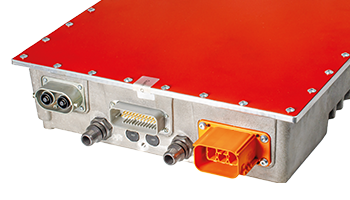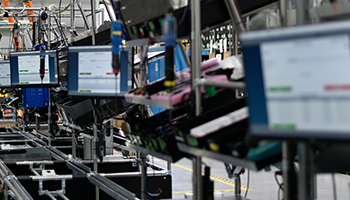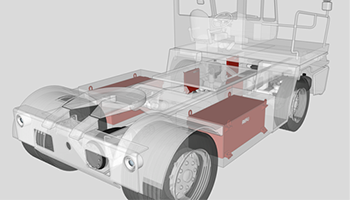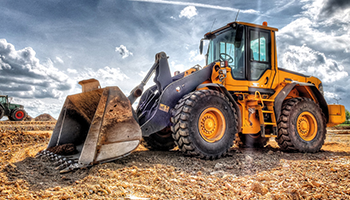Power electronics for port technology
With several inverters, on-board chargers and on-board power supplies, REFUdrive is electrifying port technology vehicles. The solutions can be used in both diesel-electric and battery-electric versions.
Terminal tractor
The workhorse in the port.
Terminal tractors are used in ports, logistics centres or on industrial railings for the handling of semi-trailers, container chassis, roll trailers and heavy-duty trailers. Depending on the area of application, the term RoRo tractor is also used or, because of the adjustable fifth wheel, the term lifting fifth wheel tractor.
-
In addition to the conventional drive with a diesel engine via a powershift transmission either on one or on two drive axles, the use of REFUdrive inverters can turn the conventional terminal tractor into a "yard horse" with zero emissions.
The diesel engine, together with the powershift transmission, is replaced by a drive unit consisting of a traction inverter and electric motor. Ancillary units such as hydraulics, compressed air and cabin air conditioning are also driven by REFUdrive inverters.
Thanks to the compactness of our RPCS 730 inverter family, the area between the axles can be used for sufficiently large battery storage to ensure equivalent operation of the terminal tractor to the conventional diesel drive without disadvantages.
-
- 1 x traction inverter RPCS 730 150K for one drive axle
- 1 x traction inverter RPCS 730 150K for second drive axle with 4x4 drive
- 1 x RPCS 730 28+4K combined inverter for the hydraulic lift and auxiliary drives and supply of the 24 VDC and 12 VDC components
- SAE-J-1939, CANpur (CANopen), cross communication for fast control functions between the inverters for synchronisation, e.g. speed, load distribution and energy management
Optional for diesel-electric operation: 1 x generator inverter RPCS 730 150K
Optional 22 kW on-board charger
Optional external 220 kW DC charging station for high-speed DC charging
Automated Guided Vehicle - AGV
Automation in high-turnover areas.
Automated guided vehicles (AGVs) are generally referred to as Automatic Guided Vehicles (AGVs). These AGVs can operate around the clock in harsh, adverse and even dangerous environments. AGVs today are essentially battery electric powered. In exceptional cases, there is also diesel-electric propulsion.
-
The batteries used for energy supply are both lead batteries and lithium-ion batteries. Using electricity from renewable sources, the AGV produces no emissions.
The vehicles can be used in almost any industry. One main area of application in intralogistics is container transport in the port. The AGVs operate around the clock without human intervention; even the "refuelling" of the AGVs is fully automatic. The self-propelled AGVs, which are controlled by a central computer, shuttle between ships and container handling areas.
Only the specialists who monitor the processes sit in the control room.
The control of the AGVs is supported by fast cross-communication between inverters within an AGV via CANpur (CANopen). This cross-communication distributes the control tasks to the individual inverters independently of the vehicle control of the AGV and thus ensures efficient energy management of the AGV as well as smooth forward running with optimal utilisation of the drive components.
-
- 2 x RPCS 630 drive inverters with 75 kW each for the drive axles
- 1 x inverter RPCS 630 for the hydraulic pump
- 1 x RPCS 630 inverter for the oil cooler and the oil pump.
- CANpur (CANopen), cross communication for fast control functions between the inverters for synchronisation, e.g. speed, load distribution and energy management
- CANopen for communication with the vehicle control system
Optional for diesel-electric operation: 1 x generator inverter RPCS 630
Optional container hoist inverter RPCS 630
Optional 220 kW DC charging station for high-voltage batteries in vehicles
Straddle Carrier
Pioneer in electrified container handling.
For the transport of containers in ports or other transhipment centres, suitable vehicles are needed that can stack containers as well as transport them. The straddle carrier is ideally suited for such cases. In the past, such systems were equipped with diesel drives and hydraulic power units, but today diesel-electric systems are the best available technology.
-
Electric drive technology has the advantage over hydraulic systems of higher energy efficiency and better regulation. It thus meets the demands of port operators to always use environmentally friendly systems with significantly lower CO2 emissions and reduced fuel consumption. Energy is also generated when lowering the hoist and braking the vehicle. With the help of an energy storage system, this energy can be efficiently reused, either for vehicle acceleration or for lifting.
The diesel engine drives the electrical generators that provide the electrical energy for all the inverters. The chassis drives are torque-controlled and operate with overriding triggers that intervene when the maximum speed is exceeded and when too high a speed is detected (differential speed of a drive is too high). They also perform checks on the brakes and monitor the motor temperature. Slip and skid control and traction control are functions that are integrated into the inverter. The linkage is speed-controlled and operates in 1:2 field weakening mode and with very short acceleration times. The inverter calculates the load, setting the maximum final speed for lowering operation. All functions are realised directly via the free configuration of the inverter, so that the higher-level PLC control is relieved of the tasks. The customer therefore does not need any special knowledge about drives. An on-board converter provides a high-quality 3 AC 400V; AC230V + N power supply. The optional DC-DC controller regulates the energy storage. -
-
4 REFUPCS 075 (chassis inverter for all-wheel drive)
-
1 REFUPCS 160 (lift inverter)
-
1 REFUPCS 045 (on-board inverter)
Optional
REFUPCS 085 DC-DC-control
CANbus (Canopen) on all REFU components for communication with the vehicle control systemSupplemented by the customer with:
Motor (synchronous generator, asynchronous motor, sensor-supported operation) Resolver, 6-pole, incremental encoder HTL/Resolver, 6-pole, incremental encoder HTL/1024 Pulses 6 double-layer capacitors 63F/125V -
Reach Stacker
Flexible stacking and handling.
Reach stackers are used for stacking and handling containers of all kinds. Due to the slanted arm, the reach stacker can grip the load units from above, if necessary across several container rows. The vehicles are primarily used in transit and logistics to load containers in ports, railway stations or industrial sites.
-
They are particularly suitable for smaller terminals and handling areas, as they are versatile and flexible despite their dimensions and high dead weight with a lifting capacity of up to 50 tonnes, thus replacing more expensive solutions such as harbour cranes or straddle carriers. Up to now, reach stackers have largely been diesel-hydraulically driven. In recent years, however, more and more diesel-electric vehicles have come onto the market. Last year, the first battery-electric reach stacker was introduced, using lithium-ion batteries. However, the challenges due to the high power required to drive the vehicles, which can weigh up to 100 tonnes, are still great.
In the diesel-electric version, a diesel generator forms an electrical intermediate circuit. From this, the chassis, pump and other systems, such as the locking system, are electrically operated. In contrast to the pure battery-electric system, the downtimes for recharging can be eliminated or reduced. At the same time, the size of the generator and thus the diesel consumption is minimised, as it no longer has to be designed for the load peaks that are covered by the battery and/or supercaps in this system.
-
- 2 x double inverters RPCS 730 2x55K for the drive axles
- 1 x inverter RPCS 730 320 K for the hydraulic lifting gear
- CANpur (CANopen), cross communication for fast control functions between the inverters for synchronisation, e.g. speed, load distribution and energy management
Optional for diesel-electric operation: 1 x generator inverter RPCS 730 150K
Optional for auxiliary operation and power supply 24V: 1x combi inverter 17K+3K
Optional 22 kW on-board charger
Optional external 220 kW DC charging station for high-voltage batteries in vehicles




